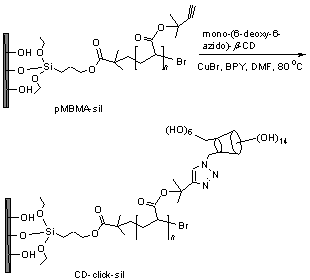1 Patten, T. E.; Matyjaszewski, K. Adv. Mater. 1998, 10, 901.  2 Kamigaito, M.; Satoh, K. Macromolecules 2008, 41, 269. 2 Kamigaito, M.; Satoh, K. Macromolecules 2008, 41, 269.  3 Hansen, N. M. L.; Jankova, K.; Hvilsted, S. Eur. Polym. J.2007, 43, 255. 4 Hemstrom, P.; Szumski, M.; Irgum, K. Anal. Chem. 2006,78, 7098. 3 Hansen, N. M. L.; Jankova, K.; Hvilsted, S. Eur. Polym. J.2007, 43, 255. 4 Hemstrom, P.; Szumski, M.; Irgum, K. Anal. Chem. 2006,78, 7098.  5 Wang, H. S.; Dong, X. C.; Yang, M. X. TrC, Trend. Anal. Chem. 2012, 31, 96. 5 Wang, H. S.; Dong, X. C.; Yang, M. X. TrC, Trend. Anal. Chem. 2012, 31, 96.  6 Gao, X. C.; Gao, B. J.; Niu, Q. Y.; Zhao, J. Acta Chim. Sinica 2010, 68, 1109 (in Chinese). (高学超, 高保娇, 牛庆媛, 赵婧, 化学学报, 2010, 68,1109.) 7 Kolb, H. C.; Finn, M. G.; Sharpless, K. B. Angew. Chem. Int. Ed. 2001, 40, 2004. 6 Gao, X. C.; Gao, B. J.; Niu, Q. Y.; Zhao, J. Acta Chim. Sinica 2010, 68, 1109 (in Chinese). (高学超, 高保娇, 牛庆媛, 赵婧, 化学学报, 2010, 68,1109.) 7 Kolb, H. C.; Finn, M. G.; Sharpless, K. B. Angew. Chem. Int. Ed. 2001, 40, 2004.  8 Li, J.; Duan, M.; Zhang, L. H.; Jiang, X. H. Prog. Chem.2007, 19, 1754 (in Chinese). (李娟, 段明, 张烈辉, 蒋晓慧, 化学进展, 2007, 19,1754.) 9 Zhang, Y. P.; Guo, Z. M.; Ye, J. X.; Xu, Q.; Liang, X. M.; Lei, A. W. J. Chromatogr. A 2008, 1191, 188. 8 Li, J.; Duan, M.; Zhang, L. H.; Jiang, X. H. Prog. Chem.2007, 19, 1754 (in Chinese). (李娟, 段明, 张烈辉, 蒋晓慧, 化学进展, 2007, 19,1754.) 9 Zhang, Y. P.; Guo, Z. M.; Ye, J. X.; Xu, Q.; Liang, X. M.; Lei, A. W. J. Chromatogr. A 2008, 1191, 188.  10 Petter, R. C.; Salek, J. S.; Sikorski, C. T.; Kumaravel, G.; Fu-Tyan, L. J. Am. Chem. Soc. 1990, 112, 3860. 10 Petter, R. C.; Salek, J. S.; Sikorski, C. T.; Kumaravel, G.; Fu-Tyan, L. J. Am. Chem. Soc. 1990, 112, 3860.  11 Wang, H. S.; Xu, D.; Jiang, P.; Zhang, M.; Dong, X. C. Analyst 2010, 135, 1785. 11 Wang, H. S.; Xu, D.; Jiang, P.; Zhang, M.; Dong, X. C. Analyst 2010, 135, 1785.  12 Wang, H. S.; Jiang, P.; Zhang, M.; Dong, X. C. J. Chromatogr. A 2011, 1218, 1310. 12 Wang, H. S.; Jiang, P.; Zhang, M.; Dong, X. C. J. Chromatogr. A 2011, 1218, 1310.  13 Alain, B.; Heng, L. J.; Thomas, E. B.; Jo, D. D.; Daniel, W. A. J. Pharmaceut. Biomed. Anal. 1990, 8, 123. 13 Alain, B.; Heng, L. J.; Thomas, E. B.; Jo, D. D.; Daniel, W. A. J. Pharmaceut. Biomed. Anal. 1990, 8, 123.  |
